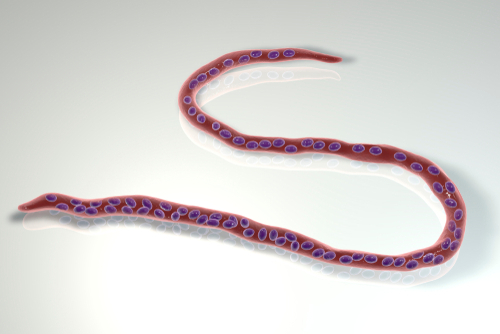Onchocerciasis, a parasitic disease caused by filarial worm Onchocerca volvulus
UNI Jun 21, 2018
Onchocerciasis – or “river blindness” – is a parasitic disease caused by the filarial worm Onchocerca volvulus transmitted by repeated bites of infected blackflies (Simulium sp).

These blackflies breed along fast-flowing rivers and streams, close to remote villages located near fertile land where people rely on agriculture. In the human body, the adult worms produce embryonic larvae (microfilariae) that migrate to the skin, eyes and other organs. When a female blackfly bites an infected person during a blood meal, it also ingests microfilariae which develop further in the blackfly and are then transmitted to the next human host during subsequent bites.
Onchocerciasis is an eye and skin disease. Symptoms are caused by the microfilariae, which move around the human body in the subcutaneous tissue and induce intense inflammatory responses when they die. Infected people may show symptoms such as severe itching and various skin changes. Some infected people develop eye lesions which can lead to visual impairment and permanent blindness. In most cases, nodules under the skin form around the adult worms.
Onchocerciasis occurs mainly in tropical areas. More than 99 per cent of infected people live in 31 countries in sub-Saharan Africa: Angola, Benin, Burkina Faso, Burundi, Cameroon, Central African Republic, Chad, Republic of Congo, Côte d’Ivoire, Democratic Republic of the Congo, Equatorial Guinea, Ethiopia, Gabon, Ghana, Guinea, Guinea-Bissau, Kenya, Liberia, Malawi, Mali, Mozambique, Niger, Nigeria, Rwanda, Senegal, Sierra Leone, South Sudan, Sudan, Togo, Uganda, United Republic of Tanzania.
Onchocerciasis is also transmitted in Yemen and the Americas. As of April 1, 2018, transmission of the parasite of onchocerciasis is still ongoing in Brazil and Venezuela.
There is no vaccine or medication to prevent infection with O. volvulus. Much progress has been made in fighting the disease in several countries through control of the blackfly, however, the disease can now also be treated with an annual dose of the drug ivermectine, Mectizan, which also relieves the severe skin itching caused by the disease.
Between 1974 and 2002, disease caused by onchocerciasis was brought under control in West Africa through the work of the Onchocerciasis Control Programme (OCP), using mainly the spraying of insecticides against blackfly larvae (vector control) by helicopters and airplanes. This has been supplemented by large-scale distribution of ivermectin since 1989.
-
Exclusive Write-ups & Webinars by KOLs
-
Daily Quiz by specialty
-
Paid Market Research Surveys
-
Case discussions, News & Journals' summaries